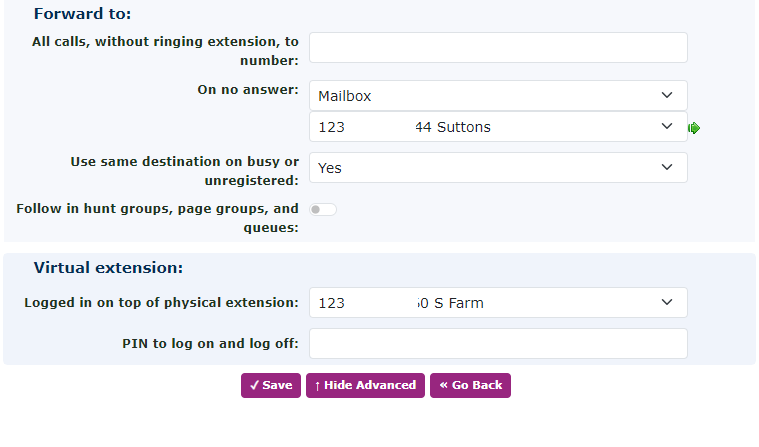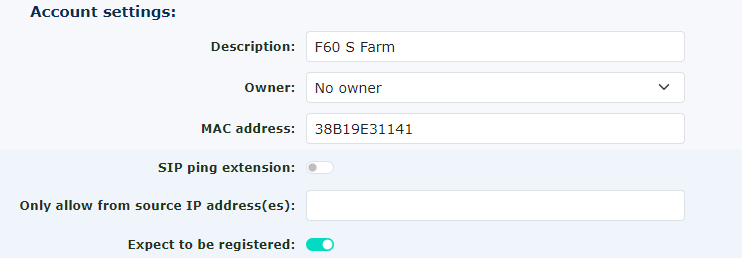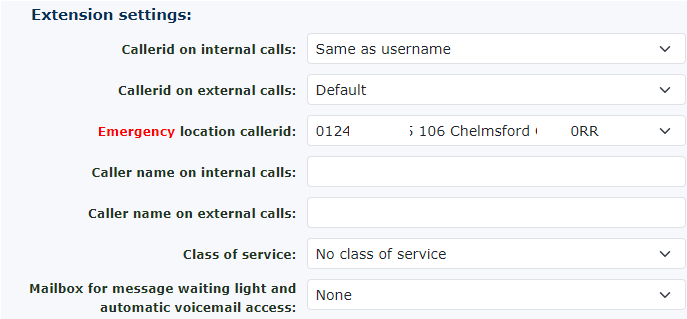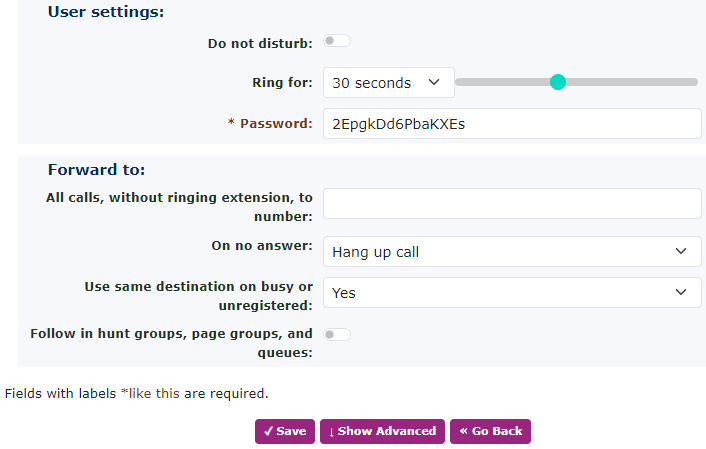|

Extension Settings
Caller ID on Internal Calls
You can choose what people see when you call internally from this telephone extension.
Caller ID on External Calls
This is the number you present to external people when you call their number. Under the numbers section, you can set one of your own telephone numbers or set it unknown to hide your number. The default settings will use the default set under Settings—Customer—Default Caller ID.
Emergency Location Caller ID
This is important, and if your customer is based in the UK, you must set the details for this telephone extension if you do not have a number offered. Please go to the Numbers section and set up the emergency address details. If you have telephones in multiple locations. You must have a Number for each location. This information will be sent to the emergency services before answering the phone. It will save lives, so please set it up.
Withhold Caller ID
You can also set here to withhold your outbound Caller ID permanently
Caller Name on Internal Calls
You can enter a name here to be displayed on internal calls.
Caller Name on External Calls
You can enter a name here to be displayed to external calls on the same network. For example, ringing from customer to customer will show this name but not to mobiles.
|
Rate Plan for Outbound Calls
It is recommended to leave this as default, but selecting a different rate plan is possible.
Class Of Service
A default Class of Service will be automatically added if you create a new extension. This blocks numbers from being called. The default has 09, 00, and other high-cost numbers. You can change this in the class of service features, but we recommend creating a new one if you need a different set of rules for this Extension.
Use Blacklist
This turns on the Black List function for this telephone extension.
Record Group
This box will be visible if you have a record group set up. You can select the record group to which you want the telephone extension to belong.
Call Rec Bundle
If the Extension is part of a call record bundle, it will show here. To add it to the call record bundle, visit the call rec bundles and add it there.
Call Spending So Far Today
This cannot be changed. It indicates what has been spent and works with the settings below.
Maximum Call Spending Per Day
In addition to your daily spending under the customer account, you can limit the amount each telephone extension can use. It is set to £5 by default, but you can increase this. We don’t recommend setting this too high, as this is part of the fraud prevention system.
Maximum Call To/From Telephone
Again, this is part of the fraud protection system. It is not recommended to increase this unless you are using the Telephone account as an SIP registration account for an old telephone system.
While Ringing
When someone calls the telephone extension, you can play music instead of playing the caller ringing. This works with the next section, Music below.
Music On Hold
You can set the Music On Hold for this particular telephone extension here. It is also used as the ‘whilst ringing’ function above.
|
|
 Pickup Groups Pickup Groups
If you have already created Pickup groups, you can add this extension to the pickup group.
Available in Hunt Groups
If you have already created Hunt Groups, you can add this telephone to your desired group, but only after you have saved the new telephone account.
Available in Queues
If you have already created Queues, you can only add this telephone after saving the new account.
Allow Callers to Enter this Telephone Line in Attendant and IVR’s
The default is set to ‘No’. Your other option is ‘Yes’. When set to ‘No', someone cannot call this telephone account via the IVR or auto attendant if they know the telephone extension number. This is an excellent feature for managers who may want to limit their external calls.
|
Send Called Number as Request URI
This feature is used if you want to use the telephone account as a SIP registration account on a telephone system. Always leave this set to ‘No’ (recommended) for use as a hosted handset on the network, but change it to ‘Yes’ (use with gateways only) when you want to set up a SIP trunk.
Send Owner Email Notification of Missed Calls
If you have an owner set above, you can set this to ‘Yes’, and the owner will receive an email on every missed call.
Mailbox for Message Waiting Light and Automatic Voicemail Access
You can select the mailbox that works with this telephone extension. Setting a Mailbox here will light the message waiting indicator on the handset (if it has one) when a call is waiting in the voicemail box. This is also used so the telephone extension can collect the messages from the mailbox without a password. It is possible to have a single Mailbox working on multiple handsets. So, if you had a company with a simple night service and no need for VM boxes for everyone. Then, they can share the main one if you set all the extensions in the same mailbox here.
Show in Reception Console
You can set it to ' No ' if you don’t want this telephone extension to show in the Reception Console. You may have a tannoy connected or a door entry unit you don’t need to show.
Use # to Transfer on Incoming Calls
It is recommended that you leave this set to default. But again, if you want limited control over the device connected, you could put this to ‘No.’
|
|
CRM Settings
This option will only appear if CRM integration is enabled under the customer settings. here.To activate If you wish to use ourthe Bubble screening poppingpop-up and CRM integration services.services, Onceplease youfollow switchthese steps: Go to CRM settings, change the CRMdropdown integrationfrom No to yes,Yes and click save. You can returnSave.
Return to the Extension or refresh the page to see the populated CRM access key.
Please perform thisthese steps for each extension requiring CRM integration and follow the instructions in the Bubble manual for further guidance.
|

|
|
 User Settings User Settings
Dial Plan
The same customer account can have various telephones in different countries. This setting can help the phone in another country use the dial plan the customer would use in that country.
Do Not Disturb
Changing from ‘Accept calls’ to ‘Refuse calls’ will send all calls to the voicemail box.
Calls Without Caller ID
Changing from ‘Accept calls’ to ‘Refuse calls’ will send all calls with a withheld number to the voicemail box.
|
Screen Calls
If this is changed to ‘Yes play Caller ID’, it will play ringing to the caller, and when you answer the phone, it will tell you the Caller ID. You can also ask the caller to record their name, and it will play their name for you, too. This is whilst the caller is listening to the ringing. If you then want to accept the call, press 1. Our recommendation is to leave this set to ‘No’ or Unchanged (default to no)
Ringing For
This is an important setting. It controls how long the telephone rings before going to Voicemail. We have set the default to 20 seconds, but you can choose from 5 seconds to 1 hour.
Password
This is another critical setting. We recommend leaving this as the randomly selected password we have given you. Please do not make all the passwords for all the telephone extensions the same. This will make it very easy if your customer gets hacked and one of the passwords is compromised. Keep it as long as suggested. You don’t need to remember this; it will be auto-provisioned if you use our provisioning system. |
|

Forward To
All Calls Without Ringing the Telephone to the Number
This will create a simple network divert to all calls on this telephone extension. You could put your external number or another telephone extension number in it.
On No Answer
If the telephone extension isn’t answered after the predetermined time above under the ‘Ring for’ settings, the call will go to this destination. Typically, this would be set to the Mailbox extension, but you could choose anything from the dropdown menu.
Use the Same Destination on Busy or Unregistered
If this is set to ‘Yes,’ it uses the above ‘on no answer’ setting. If you choose ‘No,’ it will display more menu options. Two options will appear: ‘on busy’ and ‘unregistered.’
|
On Busy
If the telephone is in use and you don’t have a call waiting, switch on the extension. Then, if the user is already on a call and a second call comes into the telephone, it will go to whatever is set here. Again, it would usually go to the mailbox and play the busy message rather than the unavailable one.
Virtual Telephone
Logged in on Top of Physical Telephone
This is the current status of the physical phone. The telephone extension is logged in on top of it. Most of the time it would be the same as the telephone Extension, however, if a telephone Extension is using hot desking then this could have a different number. This allows telephone Extensions to utilise other physical handsets around the office or home. It enables all features to move to the particular physical handset. In the case of a branded hosted handset, the display will show this telephone Extension number and busy lamp keys.
PIN to Log on and Log off
This is used to allow hot desking (virtual login). You must set a Feature Code to enable the users to log in and out. This code ensures that they are the only ones who can do it. You can log someone out via this web interface by changing the telephone Extension above.
|











